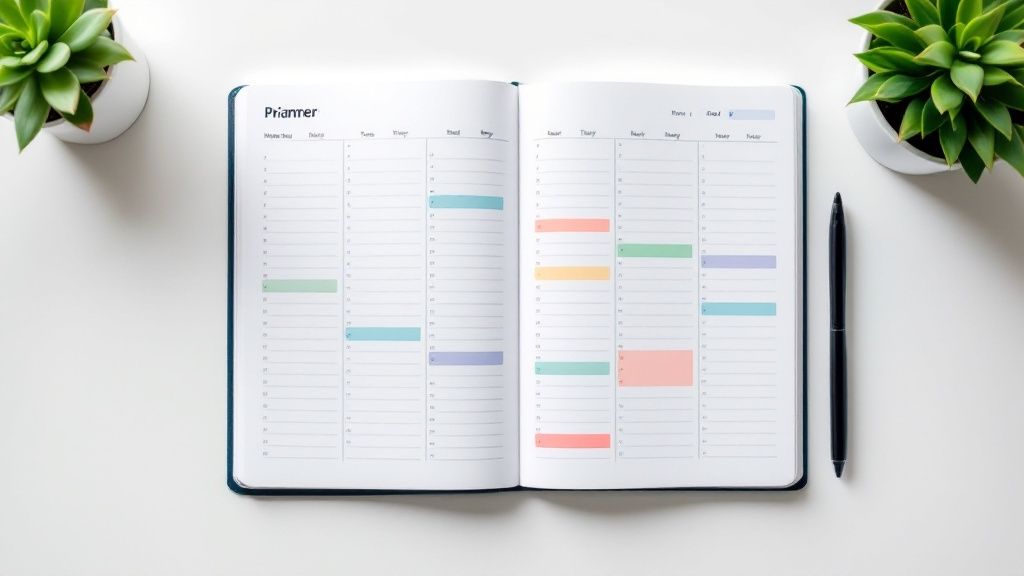
9 Proven Workplace Stress Management Techniques for 2025
Share
In today's fast-paced world, the pressure can feel relentless. Whether you're shaping young minds as an educator, building your empire as a small business owner, or crafting compelling stories as a content creator, the constant juggle of tasks, deadlines, and high expectations often leads to burnout, draining your passion and productivity. The "just push through it" mentality is not a sustainable strategy for long-term success or well-being.
But what if you could manage stress without sacrificing your goals? This article is your practical guide to navigating professional pressures with confidence and control. We're moving beyond generic advice to provide a curated roundup of proven, actionable workplace stress management techniques. From Mindfulness-Based Stress Reduction (MBSR) and Cognitive Reframing to strategic Time Blocking and effective Boundary Setting, each method is designed to be easily integrated into your busy schedule.
Our focus is on providing practical takeaways that help you reclaim your time, sharpen your focus, and foster a healthier relationship with your work. You will learn specific, implementable strategies to reduce overwhelm and boost your productivity. Let's explore the tools that will empower you to thrive, not just survive.
1. Mindfulness-Based Stress Reduction (MBSR)
Mindfulness-Based Stress Reduction (MBSR) is more than just a passing wellness trend; it's a structured, evidence-based program designed to help you rewire your brain's response to pressure. Developed by Jon Kabat-Zinn, this approach combines mindfulness meditation, body awareness, and gentle yoga. In your professional life, it gives you the tools to observe stressful thoughts and feelings from a distance, rather than being controlled by them. This practice is a cornerstone of effective workplace stress management techniques because it fosters emotional regulation and mental clarity, helping you stay grounded even on the busiest days.

Why It Works for Professionals
For busy educators, creators, and business owners, the workday is a constant barrage of demands. MBSR helps by creating a mental buffer. Instead of reacting impulsively to a stressful email or a tight deadline, you learn to pause and respond with intention. This supportive approach helps you save mental energy and increase your focus. Companies like Google and Aetna have seen tangible benefits. Aetna, for example, reported a $3,000 per employee productivity gain after implementing its mindfulness program.
A Practical Takeaway: How to Get Started with MBSR
Integrating this practice doesn't require a huge time commitment. You can start small and build momentum with these easy steps.
- Start with Short Sessions: Begin with a 5-10 minute guided meditation each day. Using an app can save you time searching for resources.
- Use the 3-Minute Breathing Space: When you feel overwhelmed, take a three-minute break. Focus on your breath, notice your body's sensations, and expand your awareness to your surroundings. It's a quick way to reduce stress.
- Designate a Quiet Space: Even a corner of your office or classroom can become a dedicated spot for a brief mindfulness practice, signaling to your brain that it's time to reset.
- Be Patient and Consistent: The benefits of mindfulness are cumulative. A consistent daily practice, even a short one, is more effective than sporadic longer sessions for long-term stress reduction.
2. Progressive Muscle Relaxation (PMR)
Progressive Muscle Relaxation (PMR) is a powerful, body-focused technique for managing stress that involves systematically tensing specific muscle groups and then releasing them. This simple method teaches you to recognize the physical sensations of tension versus relaxation. For professionals often tied to a desk, PMR is an exceptional workplace stress management technique because it directly addresses the physical toll of mental strain, releasing built-up tension in the neck, shoulders, and back.

Why It Works for Professionals
For educators, creators, and business owners, long hours of focused work can lead to unconscious muscle clenching. PMR interrupts this physical stress cycle, providing an immediate sense of relief. It’s a tangible action you can take to calm your nervous system, even during a hectic day, helping you save energy for what matters most. Companies like Johnson & Johnson incorporate PMR into their wellness programs because it helps you become more attuned to your body, allowing you to notice and release tension before it leads to headaches or chronic pain.
A Practical Takeaway: How to Get Started with PMR
Integrating PMR into your routine is straightforward and can be done right at your desk or in a quiet space for just a few minutes.
- Start with Key Areas: If you're short on time, focus on common tension spots like your hands, shoulders, neck, and face. Tense each group for 5 seconds, then release for 10-15 seconds.
- Use Audio Guidance: In the beginning, guided PMR sessions can be incredibly helpful for timing and technique, saving you the mental effort of remembering the steps.
- Focus on the Contrast: The real benefit comes from paying close attention to the feeling of release. Notice the warmth and heaviness in your muscles as the tension melts away.
- Practice Discreetly: You can practice a modified version at your desk. Tense your fists under the table or curl your toes inside your shoes without anyone noticing. It’s an easy way to reduce stress on the go.
3. Time Blocking and Priority Matrix
The combination of Time Blocking and a Priority Matrix is a powerhouse strategy for reclaiming control over your schedule and reducing overwhelm. Instead of reacting to an endless to-do list, this method proactively assigns every minute of your workday a specific job. By scheduling blocks of time for designated tasks and using a system like the Eisenhower Matrix to categorize activities by urgency and importance, you create a clear roadmap for your day—a fundamental component of effective workplace stress management techniques.

Why It Works for Professionals
For educators juggling lesson plans and grading, or creators balancing content creation with marketing, the feeling of being pulled in multiple directions is a primary source of stress. Time blocking helps you save time and increase productivity by forcing you to confront the reality of how much time you actually have. When paired with a priority matrix, it ensures you're dedicating your best energy to high-impact activities, not just urgent but unimportant distractions. This approach turns your calendar into a supportive tool for intentional focus. For educators seeking to apply these concepts, explore these powerful teacher time management strategies.
A Practical Takeaway: How to Get Started with Time Blocking
You can implement this system immediately to bring structure and calm to your workflow.
- Start with Partial Blocking: Don't try to schedule 100% of your day at first. Begin by blocking 25-50% of your time for your most critical tasks, leaving room for flexibility. This makes it less stressful to start.
- Batch Similar Tasks: Group related activities, like answering emails or making phone calls, into a single, dedicated block. This saves time by minimizing context-switching and boosting your productivity.
- Color-Code Your Calendar: Use different colors for various categories of work (e.g., green for creative tasks, blue for administrative work) to get a quick visual overview of your day.
- Schedule Buffers: Always include buffer time between blocks for transitions or unexpected interruptions. This prevents a domino effect if one task runs over, reducing stress throughout your day.
4. Workplace Boundary Setting
Workplace boundary setting is the practice of establishing clear limits around your professional life to protect your personal time, energy, and mental health. It’s about consciously deciding what you will and won't do at work, defining your availability, and gently communicating those limits to others. This crucial technique in workplace stress management prevents the blurring of lines between your job and your life, serving as a powerful defense against burnout. It's not about being uncooperative; it's about being strategic and sustainable to protect your productivity.

Why It Works for Professionals
For dedicated educators and driven business owners, the "always-on" culture can be draining. Setting boundaries helps you reclaim your autonomy and protect your most valuable resource: your focus. Instead of feeling obligated to answer every late-night email, you create a supportive structure that allows for deep work and genuine rest. Companies like Volkswagen, which configured its servers to stop delivering emails after hours, have recognized that respecting employee boundaries leads to higher engagement and long-term success. It's a key way to reduce stress for everyone.
A Practical Takeaway: How to Get Started with Boundary Setting
Implementing boundaries doesn't have to be confrontational. It's about clear, supportive communication and consistency.
- Identify Your Non-Negotiables: Start by listing where your boundaries are currently being crossed. Is it after-hours emails, excessive project requests, or interrupted lunch breaks?
- Communicate Clearly and Proactively: State your boundaries calmly and professionally. For example, "To ensure I am fully focused, I will be checking and responding to emails at 9 AM and 3 PM." This is an easy-to-read way to set expectations.
- Use Technology to Help: Set up auto-responders for after-hours communications. Let them know you've received their message and will respond during your designated work hours. This saves you time and mental energy.
- Practice Saying "No" Gently: Start small. If you can't take on a new task, you can say, "I'm focused on another priority right now, but I'd be happy to look at this next week." Offering an alternative makes the "no" feel more supportive.
5. Deep Breathing and Box Breathing Techniques
Deep breathing and box breathing are powerful, on-the-spot physiological tools that directly counteract your body's "fight or flight" response. These structured exercises work by activating the parasympathetic nervous system, which gently signals your body to calm down. The popular box breathing method, for example, involves a simple four-count cycle: inhale, hold, exhale, hold. This technique is a cornerstone of workplace stress management techniques because it's discreet, requires no equipment, and provides immediate relief.
Why It Works for Professionals
For a teacher facing a challenging classroom, a creator on a tight deadline, or a business owner navigating a tough negotiation, stress can feel overwhelming. Breathing techniques provide a direct and easy way to calm your nervous system. This is why U.S. Navy SEALs use tactical breathing to maintain focus in high-stakes environments. The ability to quickly reset your physiological state is a game-changer for maintaining composure and making clear-headed decisions under pressure, increasing your productivity when it counts.
A Practical Takeaway: How to Get Started with Box Breathing
You can integrate this powerful practice into your workday with minimal effort. It's about creating small, consistent habits that deliver significant results.
- Start with a 3-Count Box: If the standard 4-second count feels too long, begin with a 3-3-3-3 pattern. Inhale for 3, hold for 3, exhale for 3, and hold for 3. It's simple and easy to remember.
- Set Hourly Reminders: Use your phone to set a gentle reminder to do just one minute of box breathing every hour. This builds the habit and helps reduce stress throughout the day.
- Practice When Calm: Master the technique during low-stress moments, like before your workday begins, so it feels natural and automatic when you actually need it.
- Pair with Visualization: As you exhale, imagine releasing the tension from your shoulders or jaw. Visualizing the stress leaving your body can amplify the calming effect.
6. Cognitive Reframing and Perspective Shifting
Cognitive reframing is a powerful mental technique for managing workplace stress by changing the way you perceive challenging situations. Based on the principles of cognitive behavioral therapy (CBT), it involves identifying, questioning, and replacing negative thoughts with more balanced, productive ones. This method is a core component of effective workplace stress management techniques because it directly addresses the root cause of much of our stress: our interpretation of events, not the events themselves.
Why It Works for Professionals
For busy creators, educators, and business owners, negative thought spirals can be overwhelming and drain productivity. Cognitive reframing breaks this cycle. Instead of seeing a project's critique as a personal failure, you can reframe it as constructive feedback for growth. This supportive shift empowers you to transform stressors into opportunities, reducing their emotional impact and helping you move forward with a more positive and productive mindset.
A Practical Takeaway: How to Get Started with Cognitive Reframing
Putting this into practice involves becoming more aware of your internal dialogue and gently challenging it.
- Keep a Thought Record: For a week, jot down stressful situations and the automatic thoughts that follow. This is a simple, easy-to-read way to identify recurring negative patterns.
- Challenge Your Thoughts: Ask yourself, "Is this thought 100% true? What's a more supportive way to look at this?" This creates distance and objectivity.
- Use the 'Best/Worst/Most Likely' Framework: When facing a stressful event, consider the best possible outcome, the worst, and the most realistic. This often shows that your fears are overblown and helps reduce anxiety.
- Ask What You'd Tell a Friend: We often offer more compassionate, rational advice to others. Apply that same gentle perspective to your own situation to shift your viewpoint.
7. Physical Exercise and Movement Integration
Physical Exercise and Movement Integration is a proactive strategy that weaves physical activity into your daily professional life to combat stress. It operates on a simple, powerful principle: moving your body changes your mind. Exercise releases endorphins, the brain's natural mood elevators, while simultaneously reducing levels of stress hormones like cortisol. As a core component of workplace stress management techniques, it offers a tangible way to disconnect from mental pressures, save your energy, and improve cognitive function.
Why It Works for Professionals
For creators, educators, and entrepreneurs often tied to a desk, prolonged stillness can amplify stress and stifle creativity. Integrating movement provides a crucial mental reset. This isn't about training for a marathon; it's about using short bursts of activity to break up cognitive load, boost energy, and gain fresh perspectives on challenging projects. It's a supportive, easy way to increase your productivity and well-being.
A Practical Takeaway: How to Get Started with Movement Integration
You don't need a gym membership or an hour-long slot in your calendar to begin. The key is to make movement a consistent, non-negotiable part of your workday.
- Schedule Walking Meetings: For brainstorming sessions or informal check-ins, take the conversation outside or around the building.
- Use the 'Pomodoro Plus' Technique: Work in a focused 25-minute block, then use your 5-minute break for active movement like stretching or walking up and down stairs. This helps save your focus for longer.
- Create Movement Triggers: Set an hourly alarm to stand up, stretch, or do a few desk-friendly exercises. Linking movement to a recurring event, like the end of a video call, can help build the habit.
- Start Small and Build: Begin with a 10-minute walk during your lunch break. Consistency is far more impactful than intensity when you're first starting to reduce stress with movement.
8. Social Support Networks and Peer Connection
Cultivating social support networks is a powerful workplace stress management technique that prioritizes human connection over isolation. This approach involves intentionally building and maintaining supportive relationships with colleagues, creating a safety net for challenging times. Far from being just a social nicety, strong peer connections are a critical buffer against burnout, fostering a sense of belonging and shared purpose. When you can openly discuss challenges or celebrate wins with trusted peers, the weight of professional pressure becomes significantly lighter.
Why It Works for Professionals
For educators managing a demanding classroom, creators facing an algorithm change, or business owners navigating market shifts, feeling alone can amplify stress. Peer support networks create a space for shared experience and emotional validation. This supportive environment helps reduce the feeling of isolation and increases your capacity for resilience. Research from figures like Brené Brown confirms that meaningful social bonds are directly linked to job satisfaction and improved mental health.
A Practical Takeaway: How to Get Started with Peer Connection
Building a supportive network doesn't require a grand gesture; it starts with small, consistent, and easy actions. Integrating these practices can be a key part of any successful employee wellness program.
- Initiate Informal Chats: Schedule a brief virtual or in-person coffee chat with a colleague each week to connect on a human level, outside of project-specific tasks.
- Offer Help Proactively: If you see a team member is overwhelmed, gently offer your assistance. This builds reciprocal relationships based on mutual support.
- Practice Active Listening: When a colleague shares a struggle, give them your full attention without immediately offering solutions. Sometimes, simply being heard is the most valuable and supportive thing you can do.
- Join or Create a Group: Participate in company-sponsored employee resource groups or mentorship programs. If none exist, consider starting an informal peer support circle.
9. Environmental Design and Workspace Optimization
Your physical surroundings have a profound and often underestimated impact on your mental state. Environmental Design and Workspace Optimization is a practical stress management technique focused on intentionally shaping your workspace to reduce cognitive load and promote a sense of calm. This goes beyond simple tidiness; it involves leveraging elements like light, sound, organization, and nature to create an environment that supports focus and minimizes friction throughout your workday. By curating your space, you proactively remove subtle stressors that drain your energy, helping you save time and increase productivity.
Why It Works for Professionals
For creators needing deep focus or educators managing a classroom, a chaotic or poorly designed environment is a constant source of low-grade stress. Optimizing your workspace is a powerful act of self-support. Companies like Amazon, with its biophilic "Spheres" in Seattle, invest heavily in this concept because it directly correlates with employee well-being and productivity. A well-designed, supportive space reduces decision fatigue, minimizes distractions, and creates a more positive psychological association with work.
A Practical Takeaway: How to Get Started with Workspace Optimization
You don't need a corporate budget to transform your environment. Start with small, high-impact changes that make your daily routine smoother and less stressful.
- Introduce Biophilic Elements: Add a few low-maintenance plants to your desk or classroom. The presence of nature has been proven to reduce cortisol levels and improve focus.
- Control Your Lighting: If you can't be near a window, use a desk lamp with adjustable brightness. Shift to warmer tones in the afternoon to reduce eye strain. It’s an easy change with a big impact.
- Implement a "Clutter-Free Zone": Designate the immediate area around your keyboard and monitor as a strictly work-only zone. Use vertical organizers to keep essential items within reach but off your primary surface. This saves you time looking for things.
- Personalize with Purpose: Add one or two personal items that genuinely bring you joy, like a framed photo or a favorite mug. This fosters a sense of ownership and comfort without creating distracting clutter.
9 Workplace Stress Management Techniques Comparison
| Technique | Implementation Complexity | Resource Requirements | Expected Outcomes | Ideal Use Cases | Key Advantages |
|---|---|---|---|---|---|
| Mindfulness-Based Stress Reduction (MBSR) | Moderate; requires 8-week program commitment | Time for daily practice, trained instructors | Reduced stress, improved emotional regulation | Structured stress management programs | Scientifically proven, builds resilience |
| Progressive Muscle Relaxation (PMR) | Low; simple technique to learn | Minimal; quiet space and audio guides helpful | Immediate tension relief, better sleep | Physical tension relief, quick stress breaks | Easy to learn, effective for physical symptoms |
| Time Blocking and Priority Matrix | Moderate; setup and regular adjustments | Digital/calendar tools, initial planning time | Improved focus, reduced decision fatigue | Workload management, productivity boosts | Reduces multitasking, increases control |
| Workplace Boundary Setting | Moderate; requires communication and consistency | Communication tools, cultural buy-in | Prevents burnout, better work-life balance | High-demand or boundary-challenged jobs | Protects personal time, enhances respect |
| Deep Breathing and Box Breathing Techniques | Low; quick and discreet practice | None | Immediate stress relief, lowered heart rate | Situational stress relief, anytime use | No cost, discreet, fast-acting |
| Cognitive Reframing and Perspective Shifting | Moderate to high; needs ongoing practice | Self-reflection tools or professional support | Long-term resilience, reduced anxiety | Mental health improvement, stress root causes | Addresses root causes, improves coping |
| Physical Exercise and Movement Integration | Moderate; requires scheduling and facilities | Access to fitness resources, time allocation | Mood boost, lower stress hormones, better sleep | Stress management through physical health | Enhances energy and social interaction |
| Social Support Networks and Peer Connection | Moderate; ongoing relationship building | Time investment, organizational support | Reduced isolation, higher job satisfaction | Team environments, stress buffering | Emotional support, improves culture |
| Environmental Design and Workspace Optimization | High; involves physical changes and investment | Budget for furniture, plants, lighting | Reduced stress, improved productivity | Office redesign, long-term well-being | Immediate impact, enhances comfort |
Your Next Step Towards a Less Stressful Workday
Navigating the demands of the modern workplace can feel like a constant juggling act. Throughout this guide, we've explored a supportive toolkit of nine distinct workplace stress management techniques, each designed to empower you to regain control and foster a healthier relationship with your work. You've learned how to ground yourself in the present with Mindfulness, release physical tension through PMR, and strategically conquer your to-do list using a Priority Matrix.
The true power of these strategies lies not in mastering them all overnight, but in recognizing that you have options. From the immediate calm of a single Box Breathing cycle to the long-term clarity gained from setting firm boundaries, these methods offer a spectrum of support for any situation. Whether you are an educator shaping young minds, a content creator building a brand, or an entrepreneur driving a vision, your well-being is the foundation of your success. Ignoring the warning signs of burnout isn't a sign of strength; actively and gently managing your stress is.
Charting Your Course: Actionable First Steps
The journey to a less stressful career begins with a single, intentional step. Overwhelming yourself by trying to implement all nine techniques at once is counterproductive. Instead, the goal is sustainable change built on small, consistent actions.
- Reflect and Select: Which of these techniques resonated most deeply with your current challenges? If you constantly feel overwhelmed by your workload, start with Time Blocking. If you find yourself physically tense after a long day, commit to practicing Progressive Muscle Relaxation before bed.
- Start Small: Your initial commitment doesn't need to be monumental. Can you dedicate just five minutes each morning to a deep breathing exercise? Can you block off one 30-minute period this week to optimize your physical workspace?
- Track Your Progress: Keep a simple journal or a note on your phone. After a week of practicing your chosen technique, ask yourself: How has my energy shifted? Am I reacting differently to stressors? This gentle reflection reinforces the positive impact and motivates you to continue.
Ultimately, mastering these workplace stress management techniques is an investment in your most valuable asset: yourself. It’s a proactive practice that builds resilience, enhances focus, and unlocks a more sustainable and fulfilling professional life. By choosing to engage with these tools, you are not just coping with stress; you are actively designing a workday that supports your mental and emotional health, allowing your productivity and creativity to flourish.
Ready to take your productivity and stress management to the next level? Explore the digital downloads and AI-powered organizational tools at fenjaeducation.net. Our resources are specifically designed to help educators, creators, and small business owners streamline their workflows, save precious time, and protect their well-being. Visit fenjaeducation.net to discover how our practical solutions can support your journey toward a more balanced and successful career.